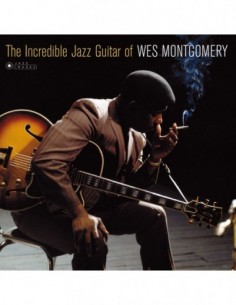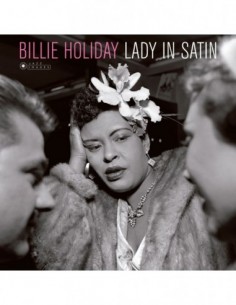At Town Hall
Nina SimoneTHE JEAN-PIERRE LELOIR COLLECTION
180 PRE VIRGIN VINYL LPs IN GATEFOLD PACKAGING
INCLUDES 1 BONUS TRACK
5 STARS ALL MUSIC GUIDE
Nina Simone’s first recording ever, the 1957 LP "Little Girl Blue", featured the singer backing herself on piano, with Jimmy Bond on bass and Albert “Tootie” Heath on drums. That was the exact personnel present during her first big break: the recording taped at her September 12, 1959 concert at New York’s Town Hall, issued that same year as Nina Simone at Town Hall. Presented here in its entirety, the album includes such classics as “Black Is the Color of My True Love’s Hair”, “The Other Woman”, and an extended reading of Gershwin’s “Summertime”.
PERSONNEL:
NINA SIMONE, piano & vocals
JIMMY BOND, bass
ALBERT “TOOTIE” HEATH, drums
Town Hall, New York, September 12, 1959.
BONUS TRACK (B6): Same personnel. New York, December 1957.
SIDE A:
01 BLACK IS THE COLOR OF MY TRUE LOVE’S HAIR
02 EXACTLY LIKE YOU
03 THE OTHER WOMAN
04 UNDER THE LOWEST
05 YOU CAN HAVE HIM
SIDE B:
01 SUMMERTIME [Parts 1 & 2]
02 COTTON-EYED JOE
03 RETURN HOME
04 WILD IS THE WIND
05 FINE AND MELLOW
06 MY BABY JUST CARES FOR ME (*)
(*) BONUS TRACK
- Format
- LP
- Discs
- 1
- Label code
- 37057

Nina Simone
Nina Simone is the eclecticism in a breathy, singular, stifled-breathing voice, with a contralto typical of the African-American musical universe of the last century.
With the real name of Eunice Kathleen Waymon, but also known as the High Priestess of Soul, Nina was an American pianist, singer and composer and, above all, one of the greatest exponents of blues, jazz and soul.
Listening to her, watching her sing or enjoying one of her performances in front of the piano, with that strength of voice and that stage presence that characterized her, is still awe-inspiring. Nina Simone captivated her audience with the kind of musical combinations that forged her own genuine style: improvisation, silence, sporadic shouting or wailing and a minimalist accompaniment that generated a high level of intimacy with her audience.
BIOGRAPHY
Nina was born in Tryon, North Carolina, on February 21, 1933 and died in Carry Le Rouet, France, on April 21, 2003. Her life was marked by adverse circumstances related to racism, which influenced her musical training, her struggle for the civil rights of people of African descent and many of the decisions she made throughout her life.
In her early years, Nina Simone was moved by an intense interest in classical music: at the age of two she began to play the piano and at the age of twelve she gave an anecdotal recital, as her parents, seated in the front row, were forced to leave because they were occupying seats that corresponded to whites. Nina stopped the recital until her parents returned to the front row.
This anecdote, in addition to the rejection she received at the Curtis Institute of Music for being black and a situation of poverty, led her to abandon classical music and approach jazz and blues, which she got to know while working in nightclubs. Raped, exploited and even ruined by her own husband (Andrew Stroud), Nina Simone left the United States after suffering disagreements with artistic agents and record labels, but above all she left her country because she was tired of the racism of American society.
MUSICAL INFLUENCES
Nina Simone's legacy (jazz, soul, blues, gospel), translates into 40 albums, a place in the North Carolina Hall of Fame, four Grammy nominations and a place also in the Rock and Roll Hall of Fame in 2018.
But beyond the musical influence left by her career, recognized by record labels such as RCA, Phillips or Colpix, with whom she produced numerous albums and singles, Nina Simone (Music and civil rights), left a legacy of struggle and resistance for civil rights, to whom she even dedicated a good part of her musical career and for which she was even admired, respected and turned into a reference.
COLLABORATORS IN PERFORMANCE
Although in the last years of her career she was accompanied by Paul Robinson on drums, Tony Jones on bass, Leopoldo Fleming on percussion and Al Schackman on guitar and musical direction, Nina Simone developed a career from the musical intimacy or, in other words, from the tendency to make her voice the main protagonist. However, Nina Simone managed to include herself among the artists and share the stages of social struggles with artists such as Harry Belafonte, Joan Baez, Anthony Perkins, Peter, Paul & Mary. She was also able to perform songs with Ray Charles and Emile Latimer, and exerted an important influence on the music of Bob Dylan.
DISCOGRAPHY
Nina Simone's discography is wide and varied, take a look at a lifetime of musical production, arranged chronologically (Nina Simone Allmusic):
1957: My Baby Just Cares for Me
1958: Little Girl Blue
1959: Nina Simone And Her Friends
1959: The Amazing Nina Simone
1959: Nina Simone At Town Hall
1960: Nina Simone At Newport
1960: Forbidden Fruit
1962: Nina At The Village Gate
1962: Nina Simone Sings Ellington
1963: Nina's Choice
1963: Nina Simone At Carnegie Hall Live
1964: Folksy Nina
1964: Nina Simone In Concert
1964: Broadway-Blues-Ballads
1965: I Put A Spell On You
1965: Pastel Blues
1966: Nina Simone With Strings
1966: Let It All Out
1966: Wild Is The Wind
1967: High Priestess Of Soul
1967: Nina Simone Sings The Blues
1967: Silk & Soul
1968: Nuff Said
1969: A Very Rare Evening
1969: Nina Simone And Piano
1969: To Love Somebody Studio
1970: Black Gold
1971: Here Comes The Sun
1972: Emergency Ward
1974: It Is Finished
1978: Baltimore
1980: The Rising Sun Collection
1982: Fodder On My Wings
1985: Nina's Back
1985: Live & Kickin
1987: Let It Be Me
1987: Live At Ronnie Scott's
1993: A Single Woman
2003: Gold
MOST FAMOUS SONG
In "Feeling Good", Nina Simone has already earned worldwide recognition. Beyond this song, the singer also immortalized songs such as "I Loves You, Porgy", her first single and immediately popular; "I Wish I Know How It Would Feel To Be Free", "Aint Got No-I Got Life", or the versions with the best of her style of "Just Like a Woman", "Here comes the sun" or "Suzanne".
Other emblematic versions were also: "I Put a Spell on You", by the Beatles; and "House of the Rising Sun", later also covered by Bob Dylan and The Animals.
Nina Simone was a versatile, minimalist artist, focused more on her voice and piano playing than on baroque or overloaded arrangements. In addition to her musical quality, Nina was at the height of her time and knew how to combine music with the message of her deepest concerns. Her voice and piano can be placed in any important collection of jazz, blues or soul, even gospel, but also within the film repertoire that gave her talent a place in numerous soundtracks.
 Cookie preferences
Cookie preferences





























































